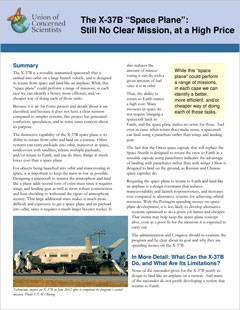The X-37B is a reusable unmanned spacecraft that is carried into orbit on a large launch vehicle, and is designed to return from space and land like an airplane. While this “space plane” could perform a range of missions, in each case we can identify a better, more efficient, and/or cheaper way of doing each of those tasks.
The X-37B being prepared for launch.
Because it is an Air Force project and details about it are classified, and because it does not have a clear mission compared to simpler systems, this project has generated confusion, speculation, and in some cases concern about its purpose.
The distinctive capability of the X-37B space plane is its ability to return from orbit and land on a runway. Other systems can carry payloads into orbit, maneuver in space, rendezvous with satellites, release multiple payloads, and/or return to Earth, and can do these things at much lower cost than a space plane.
For objects being launched into orbit and maneuvering in space, it is important to keep the mass as low as possible. Designing a spacecraft to reenter the atmosphere and land like a plane adds several tons of extra mass since it requires wings and landing gear as well as more robust construction and heat-shielding to withstand the rigors of atmospheric reentry. That large additional mass makes it much more difficult and expensive to get a space plane and its payload into orbit, since it requires a much larger booster rocket. It also reduces the amount of maneuvering it can do with a given amount of fuel once it is in orbit.
Thus, the ability to return to Earth carries a high cost. Many missions in space do not require bringing a spacecraft back to Earth, and the space plane makes no sense for those. And even in cases when return does make sense, a spacecraft can land using a parachute rather than wings and landing gear.
The fact that the Orion space capsule that will replace the Space Shuttle is designed to return the crew to Earth in a reusable capsule using parachutes indicates the advantage of landing with parachutes rather than with wings. Orion is designed to land on the ground, as Russian and Chinese space capsules do.
Requiring the space plane to return to Earth and land like an airplane is a design constraint that reduces maneuverability and launch responsiveness, and increases cost compared to alternative systems for achieving orbital missions. With the Pentagon spending money on space-plane development, it is less likely to develop alternative systems optimized to do a given job better and cheaper. That inertia may help keep the space-plane concept alive, even as a poor fit for the missions it is expected to carry out.
The administration and Congress should re-examine the program and be clear about its goal and why they are spending money on the X-37B.




